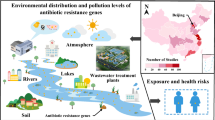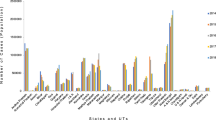Abstract
The numbers of presumptiveLegionella pneumophila cells in waters and sediments of nine different cooling towers located on the same site in the northeastern United States were determined at approximately monthly intervals for 18 months. All systems received makeup water from the same source and received the same chemical treatments. PresumptiveL. pneumophila were found in both water and sediment samples from all systems on all sampling dates. An important result of this study was the finding that tower sediments represent large reservoirs ofL. pneumophila. The only correlation between levels of presumptiveL. pneumophila and any of the physical, chemical, or operating characteristics evaluated was with winter shutdown and drainage followed by a nonoperational period. These systems showed a definite seasonal response with the highest levels of presumptiveL. pneumophila found in the summer and fall. Systems operated year round showed relatively constant numbers ofL. pneumophila in both water and sediments.
Similar content being viewed by others
Literature Cited
Bettinger, G. E., Fynsk, A. E., Fliermans, C. B. 1980. Detection ofLegionella pneumophila in cooling towers not associated with disease outbreak. Abstracts of the Annual Meeting of the American Society for Microbiology1980:288.
Braun, E. B., Baker, M., Pope, D. H. 1981. Occurrence ofLegionella pneumophila (Legionnaires' disease bacteria) in Northeastern U.S. lakes. In: Boylen, C. W. (ed.), The Lake George ecosystem. New York: Lake George Association.
Center for Disease Control. 1978. Legionnaires' Disease-Atlanta, Georgia. Morbidity and Mortality Weekly Report27:293.
Cherry, W. B., Pittman, B., Harris, P. P., Herbert, G. A., Thompson, B. M., Thacker, L., Weaver, R. E. 1978. Detection of Legionnaires disease bacteria by direct immunoflourescent staining. Journal of Clinical Microbiology8:329–338.
Cordes, L. G., Fraser, D. W., Skaliy, P., Perlino, C. A., Elsea, W. R., Mallison, G. F., Hayes, P. S. 1980. Legionnaires disease outbreak in an Atlanta, Georgia, country club: evidence for spread from an evaporative condenser. American Journal of Epidemiology111:425–431.
Dundero, T. J., Rendtorff, R. C., Mallison, G. F., Weeks, R. L., Levy, J. S., Wong, E. W., Schaffner, W. 1980. An outbreak of Legionnaires' disease associated with a contaminated air-conditioning cooling tower. New England Journal of Medicine302:365–370.
England, III, A. C., Fraser, D. W., Mallison, G. F., Mackel, D. C., Skaliy, P., Gorman, G. W. 1982. Failure ofLegionella pneumophila sensitivities to predict culture results from disinfectant-treated air conditioning cooling towers. Applied and Environmental Microbiology43:240–244.
Fliermans, C. B., Cherry, W. B., Orrison, L. H., Smith, S. J., Tison, D. L., Pope, D. H. 1981. Ecological distribution ofLegionella pneumophila. Applied and Environmental Microbiology,41:9–16.
Fraser, D. W. 1980. Legionellosis: evidence of airborne transmission. Annals of the New York Academy of Sciences353:61–66.
Fraser, D. W., Tsai, T. R., Orenstein, W., Parkin, W. E., Beecham, H. J., Scharrar, R. G., Harris, J., Mallison, G. F., Martin, S. M., McDade, J. E., Shepard, C. C., Brachman, P. S., The Field Investigation Team. 1977. Legionnaires' disease, description of an epidemic of pneumonia. New England Journal of Medicine297:1189–1196.
Glick, T. H., Gregg, M. B., Berman, B., Mallison, G., Rhodes, Jr., W. W., Kassannoff, I. 1978. Pontiac Fever: an epidemic of unknown etiology in a health department. I. Clinical and epidemiologic aspects. American Journal of Epidemiology197:149–160.
Grace, R. D., Dewar, N. E., Barnes, W. G., Hodges, G. R. 1981. Susceptibility ofLegionella pneumophila to three cooling tower microbicides. Applied and Environmental Microbiology41:233–236.
Orrison, W. H., Cherry, W. B., Milan, D. 1981. Isolation ofLegionella pneumophila from cooling tower water by filtration. Applied and Environmental Microbiology41:1202–1205.
Skaliy, P., Thompson, T. A., Gorman, G. W., Morris, G. K., McEachern, H. V., Mackel, D. C. 1980. Laboratory studies of disinfectants againstLegionella pneumophila. Applied and Environmental Microbiology40:697–700.
Soracco, R. J., Gill, H. K., Fliermans, G. B., Pope, D. H. 1983. Susceptibilities of algae andLegionella pneumophila to cooling tower biocides. Applied and Environmental Microbiology45:1254–1260.
Stout, J., Yu, V., Vickers, R. M., Zuraleff, J., Best, M., Brown, A., Yee, R. B., Wadowsky, R. 1982. Ubiquitousness ofLegionella pneumophila in the water supply of a hospital with endemic Legionnaires' disease. New England Journal of Medicine306:466–468.
Author information
Authors and Affiliations
Rights and permissions
About this article
Cite this article
Howland, E.B., Pope, D.H. Distribution and seasonality ofLegionella pneumophila in colling towers. Current Microbiology 9, 319–323 (1983). https://doi.org/10.1007/BF01588827
Issue Date:
DOI: https://doi.org/10.1007/BF01588827




